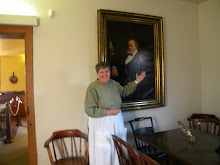The Lord said in D & C 125 "Let them build up a city unto my name upon the land opposite the city of Nauvoo, and let the name of Zerahemla be named upon it." I have read this in the Doctirne and Covenants and now I have been there.

The Last House on the Road to Zerahemla sounds like something that should be written as a book. Mike showed us where the Zerahemla Road was, and then marked off where the last house on the road was located before it went in to the cemetery. I pondered about the family that would have lived there. I'm guessing it would have been their responsibility to care for the cemetery. I wondered what they were thinking when they packed up their wagons and moved west or what they were thinking when they saw their friends and family pack up and move west and they stayed.

Using the divining rods--otherwise known as 2 metal coat hangers, I was able to find a grave. It was so amazing to walk along and watch those two rods cross and then walk a little further and see them separate. I did it about three times, and then called Mike, who is with the sledge hammer, over and asked him to verify what I had found. Sure enough, I had found a grave of an adult. It was about 6 feet long and 3 feet wide. There was also evidence of a fence having been pitched around the grave. Mike took his sledge hammer and drove in a stake marking the grave. One of the people said, "Maybe it was your ancestor." I said that I didn't think so, but even if wasn't, I have such a strong connection to the early Saints of Nauvoo that they all seem like my family.

The cemetery at Zerahemla. I don't know why, but it makes much more sense to me that a place really did exist if there is a cemetery there. There are only about 8 headstones left, but Mike has been able to come up with many more graves as you can see the wooden markers that have been placed. Unfortunately, we don't know the names of the individuals.

As we pulled up to this site, Mike Foley, our director, said, "Somewhere behind those trees was where Zerahemla (the modern version) was located. I thought that's all we were going to get, but then we started walking and got back to Zerahemla.
 The barge floating into the lock. There are large cables tied to either side to keep it on a straight course. It takes about 10 minutes to get all the way from the back to the front.
The barge floating into the lock. There are large cables tied to either side to keep it on a straight course. It takes about 10 minutes to get all the way from the back to the front. The railroad and road swings back. This is the old road before the new bridge was built, but the railroad still uses the track, so they can't just take it out.
The railroad and road swings back. This is the old road before the new bridge was built, but the railroad still uses the track, so they can't just take it out. The gates of the lock swing open. That is so amazing to see such large gates open up!
The gates of the lock swing open. That is so amazing to see such large gates open up! The gates begin to open. They swing back into an indentation that allows the barge to float through freely.
The gates begin to open. They swing back into an indentation that allows the barge to float through freely. The front of the barge starts to move through the gates. At first, it looked like it only had about one foot clearance on each side, but upon closer examination, it had a whole three feet on each side.
The front of the barge starts to move through the gates. At first, it looked like it only had about one foot clearance on each side, but upon closer examination, it had a whole three feet on each side.
















